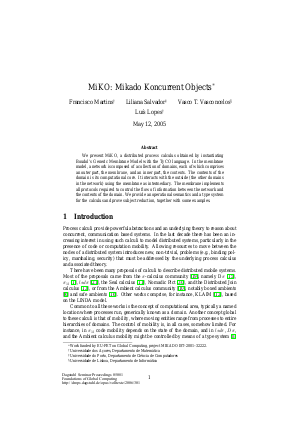MiKO---Mikado Koncurrent Objects
Authors Francisco Martins, Liliana Salvador, Vasco T. Vasconcelos, Luís Lopes
-
Part of:
Volume:
Dagstuhl Seminar Proceedings, Volume 5081
Part of: Series: Dagstuhl Seminar Proceedings (DagSemProc) - License:
 Creative Commons Attribution 4.0 International license
Creative Commons Attribution 4.0 International license
- Publication Date: 2006-01-31
File

PDF
DagSemProc.05081.6.pdf
- Filesize: 0.53 MB
- 43 pages
Document Identifiers
Subject Classification
Keywords
- Global computing
- code migration
- administrative domains
- process calculus
Metrics
- Access Statistics
-
Total Accesses (updated on a weekly basis)
0Document
0Metadata
Abstract
The motivation for the Mikado migration model is to provide programming constructs for controlling code mobility that are as independent as possible from the particular programming language used to program the code. The main idea is to regard a domain (or site, or locality), where mobile code may enter or exit, as a membrane enclosing running processes, and offering services that have to be called for entering or exiting the domain. MiKO---Mikado Koncurrent Objects is a particular instance of this model, where the membrane is explicitly split in two parts: the methods defining the interface, and a process part describing the data for, and the behavior of, the interface. The talk presents the syntax, operational semantics, and type system of MiKO, together with an example. It concludes by briefly mentioning the implementation of a language based on the calculus.
Cite As Get BibTex
Francisco Martins, Liliana Salvador, Vasco T. Vasconcelos, and Luís Lopes. MiKO---Mikado Koncurrent Objects. In Foundations of Global Computing. Dagstuhl Seminar Proceedings, Volume 5081, pp. 1-43, Schloss Dagstuhl – Leibniz-Zentrum für Informatik (2006)
https://doi.org/10.4230/DagSemProc.05081.6
BibTex
@InProceedings{martins_et_al:DagSemProc.05081.6,
author = {Martins, Francisco and Salvador, Liliana and Vasconcelos, Vasco T. and Lopes, Lu{\'\i}s},
title = {{MiKO---Mikado Koncurrent Objects}},
booktitle = {Foundations of Global Computing},
pages = {1--43},
series = {Dagstuhl Seminar Proceedings (DagSemProc)},
ISSN = {1862-4405},
year = {2006},
volume = {5081},
editor = {Jos\'{e} Luiz Fiadeiro and Ugo Montanari and Martin Wirsing},
publisher = {Schloss Dagstuhl -- Leibniz-Zentrum f{\"u}r Informatik},
address = {Dagstuhl, Germany},
URL = {https://drops.dagstuhl.de/entities/document/10.4230/DagSemProc.05081.6},
URN = {urn:nbn:de:0030-drops-3014},
doi = {10.4230/DagSemProc.05081.6},
annote = {Keywords: Global computing, code migration, administrative domains, process calculus}
}
